 NEWS NEWS
TLC LAUNCHES “OPERATION: SECRET RIDER TO ENFORCE PASSENGER BILL OF RIGHTS
The New York City Taxi and Limousine Commission (TLC) launched a new undercover initiative designed to measure the compliance of medallion taxicab drivers with regulations:
- prohibiting cell phone use and rudeness,
- allowing passengers to use credit cards for payment, as well as
- other regulations tied to the “Taxi Passenger Bill of Rights.”
Operation: Secret Rider, modeled to some extent after the “secret shopper” quality assurance programs that have been successfully used in the retail and service industries, kicked off simultaneously today in various locations throughout the city.
TLC Officers, also known as New York’s Proudest, have been specially trained to simulate both local and tourist taxi passengers, and ride an unspecified distance to gauge drivers’ performance in delivering the levels of customer service required by law.
Balancing the positive with the negative, TLC Officers will also be on the lookout for drivers that provide exemplary service flagging them for consideration of honors at the TLC’s Annual Driver Recognition Ceremony.
Said TLC Commissioner Matthew W. Daus, “Passengers deserve a driver whose full attention is to the job, and who is ready, willing and able to follow the Passenger Bill of Rights to a ‘T.’ Most drivers understand that they are professionals working in a service industry, and do a great job. We believe this program will very effectively drive the point home to those who don’t fully understand that fact, and prevent our having to stiffen penalties to make the same point.
“The bottom line is that drivers will never know whether their passenger is a ‘Secret Rider’, so the sooner they get their priorities in order, the better.”
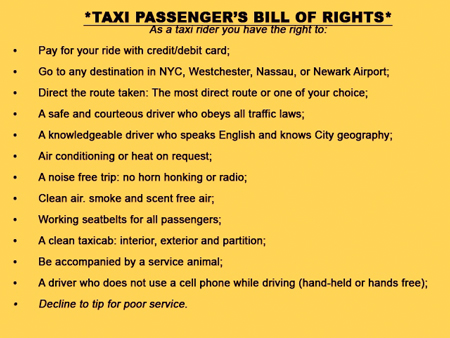
Selected Enforcement Categories and Associated Penalties
- Driver may not refuse Passenger Request of method of payment, including credit card
Fine: $150 - $350.
- Driver may not use a telephone while operating a taxicab, unless such taxicab shall be legally standing or parked
Fine: $200, plus 2 Persistent Violator Program Points
- A driver shall be courteous to passengers
Fine: $150 plus 2 Persistent Violator Points
The Persistent Violator Program (PVP) accrues, upon conviction, points for violations of TLC regulations typically specific to providing customer service. If a driver reaches a threshold of six PVP points within a 15 month floating window the driver will receive a 30 day TLC license suspension. If a driver reaches a threshold of 10 PVP points within such a 15 month period the penalty is automatic TLC license revocation.
While Operation: Secret Rider will be the most public aspect of this customer service initiative the TLC will be pursuing other avenues to ensure that passengers receive the highest levels of customer service to which they are entitled, and the Passenger Bill of Rights promises.
For one thing, the TLC will be “beefing up” the Bill of Rights to include such things as “the right to pay by debit or credit card on request.” This will put drivers on notice as to what is expected of them, as well as informing passengers about what is and what is not acceptable in terms of the regulations and code of conduct that all drivers must follow in order to provide the expected passenger experience.
The New York City Taxi and Limousine Commission (TLC) was created in 1971, and is the agency responsible for the regulation and licensing of almost 200,000 yellow medallion taxicabs and for-hire vehicles, their drivers, and the businesses that operate and support their industries. It is recognized as the largest and most active taxi and limousine regulatory body in the United States.
To find out more about the TLC, or to review its rules, regulations and procedures, we encourage you to visit our official web site at http://www.nyc.gov/taxi or call 311 in New York City, or 212-NEW-YORK from outside of New York City.
Office of the Deputy Commissioner for Public Affairs
40 Rector Street, 5th Floor
New York NY 10006
Tel: 212-676-1013, Fax: 212-676-1101
THE HACK UP
What’s good about the current taxi fleet?
And what could be improved?
Given the tough driving conditions that New York’s cabs must withstand—a 24/7 regime of stop-and-go traffic, weather extremes, and bouncy roads— the current prevalence of Ford Crown Victorias is pretty sensible: the vehicles are affordable workhorses, safe and spacious for their class, and easy to maintain. New York’s fleet is also quite new, with a mandatory three-year retirement age extended to five years only if the car is driver-owned or a hybrid or accessible model. Still, cabs could be more userfriendly. Current taxis offer little in the way of amenities for drivers who spend up to 12 hours in the front seat. Passengers say that it is hard to get in and out of the back, hard to see over the partition, and difficult to accommodate luggage and children. Although more than 80% of Crown Vics feature ‘stretch’ interiors, providing 45.6” of legroom, the car also takes up nearly 18 feet of road length—more than may be appropriate on a small island.
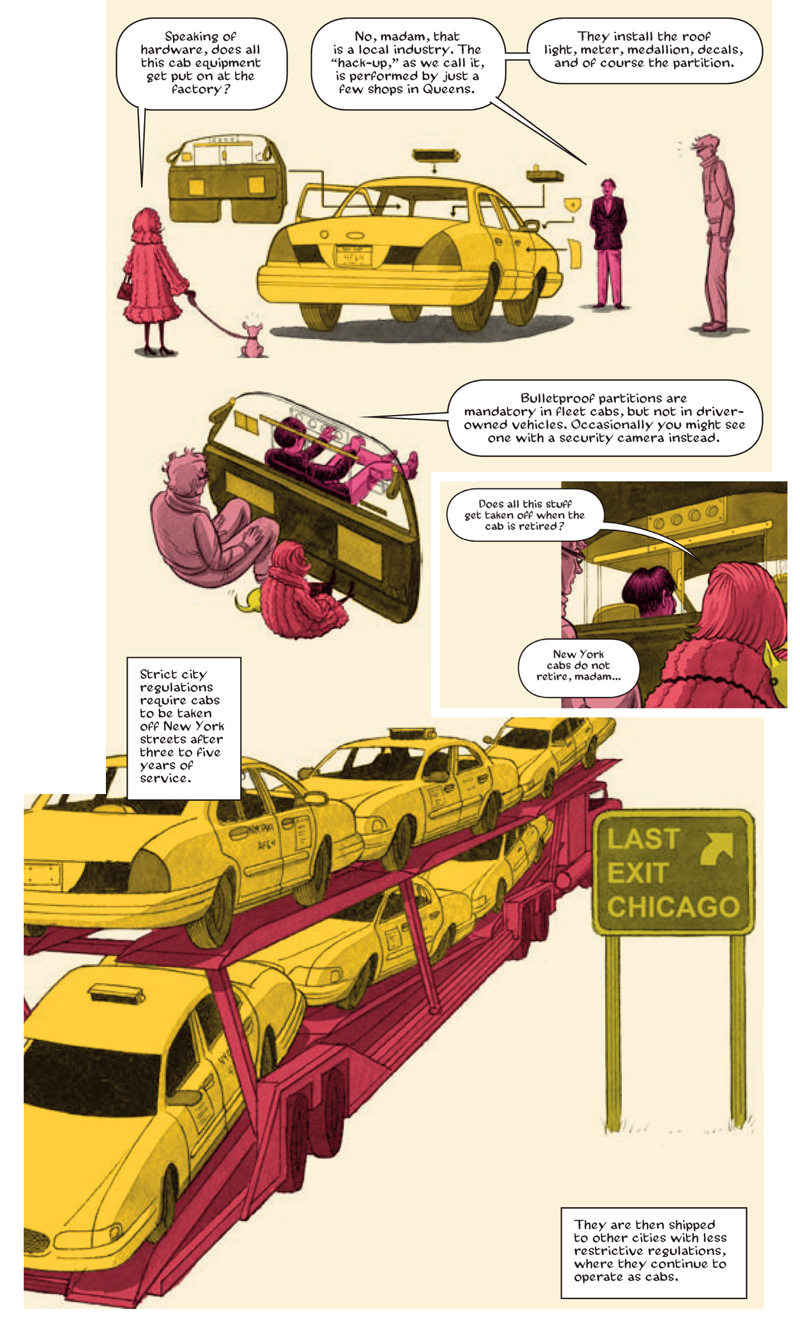
HOW DO CARS BECOME CABS ?
A Ford Crown Victoria costs approximately $27,500. The ‘hackup,’ the process that transforms the new vehicle into a hack vehicle—that is, a taxicab—costs another $3,000. Taxi vehicles are typically painted yellow by the original manufacturer, but the hack-up takes place in Queens or the Bronx, where specialized taxi garages add a range of functional and identifying elements, all required by the TLC. The roof light and the medallion badge are attached to the car’s exterior.
Stickers with fare information are affixed to the doors, and the medallion number is stenciled on. Inside, the meter is connected and a partition is usually installed. (Owner-operators are exempt from the partition requirement, and some choose not to install one, as tips are usually better without.)
The technology enhancements mandated for roll-out in 2007 will add several more steps—and approximately $5,000—to the average hack-up process.
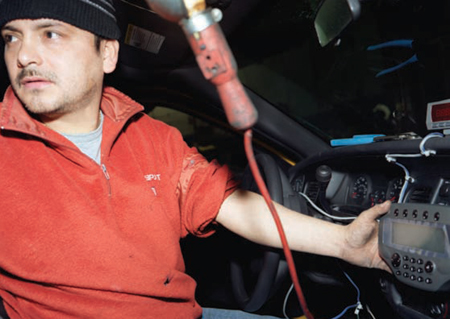
Darwin Pasato (above), a hack-up mechanic, installs a driver information monitor on the dash of a new cab. He connects this new meter, or “DIM”, to a new passenger information monitor or “PIM” on the customer side of the partition. This key TLC technology enhancement will allow passengers to view real-time route maps, look up TLC information en route, and at the end of the ride, pay the metered fare on screen with a credit card. Meanwhile, this road weathered Crown Victoria (below) gets a body and paint makeover so that it can pass its next inspection.

UNDERSTANDING THE TYPICAL CAB RIDE
What hapens during a cab ride?
What interactions define the taxi experience ?
Taxis operate within the geographical landscape of the city’s streets, avenues, bridges, and tunnels. Though it’s less obvious, every cab also exists in a “communications landscape” that includes not just conversations between riders and drivers, but also meter readings, tripsheets, inspection reports, licenses, 1010 WINs travel headlines, calls to 311, text messages, relief stand hearsay, neighborly advice, receipts, public service announcements, maps, and advertisements. All of these points of exchange and information delivery influence how New Yorkers perceive their taxi experience.
The graphic below outlines the transactions that make up a typical cab ride. Key moments include the point of connection between rider and driver, the exchange of destination and route information, the lull of the ride itself, and the arrival and payment process. When considering how the taxi system works today—and how it might be improved in the future—it’s helpful to consider how each of these phases of the ride might be better informed, easier to carry out, and more enjoyable for both passenger and driver.

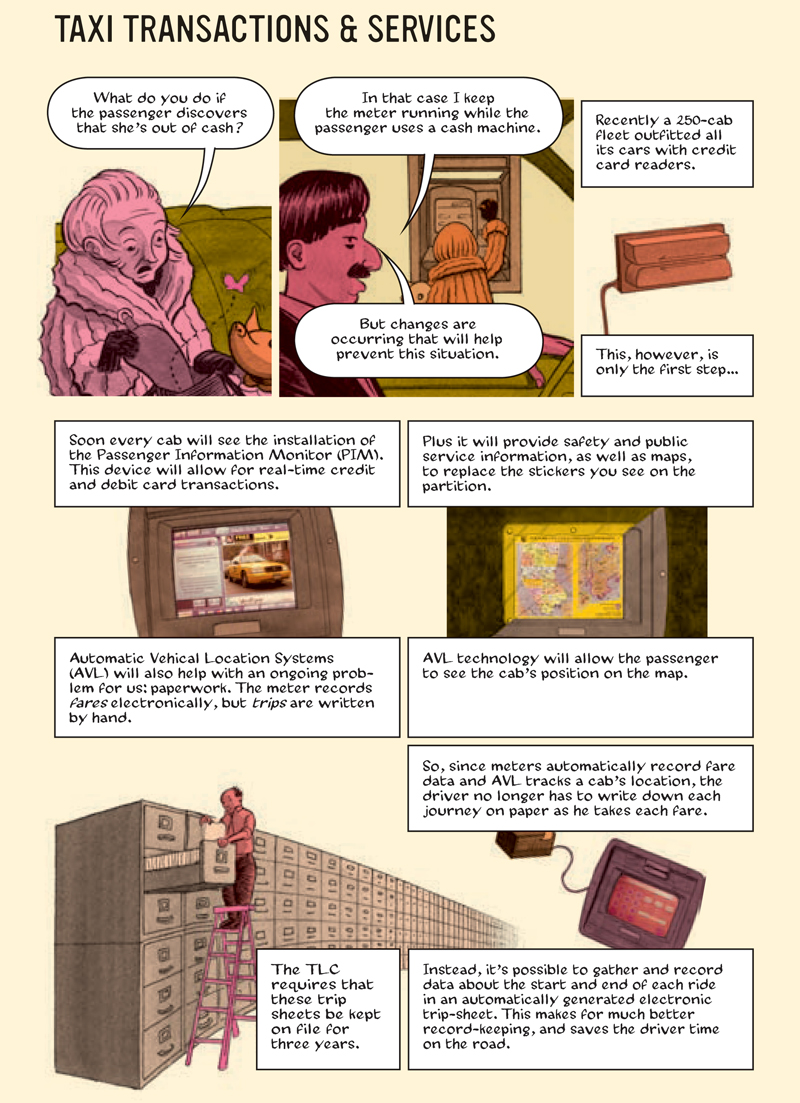
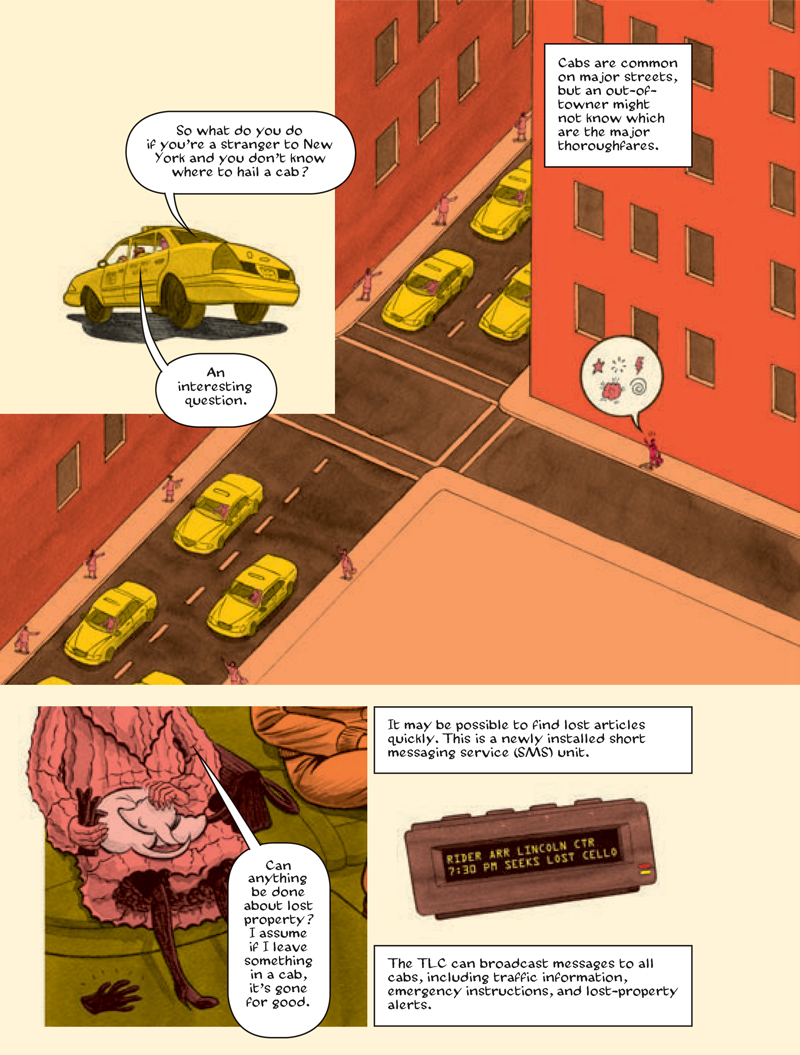
© 2015 TLC Magazine Online, Inc. |